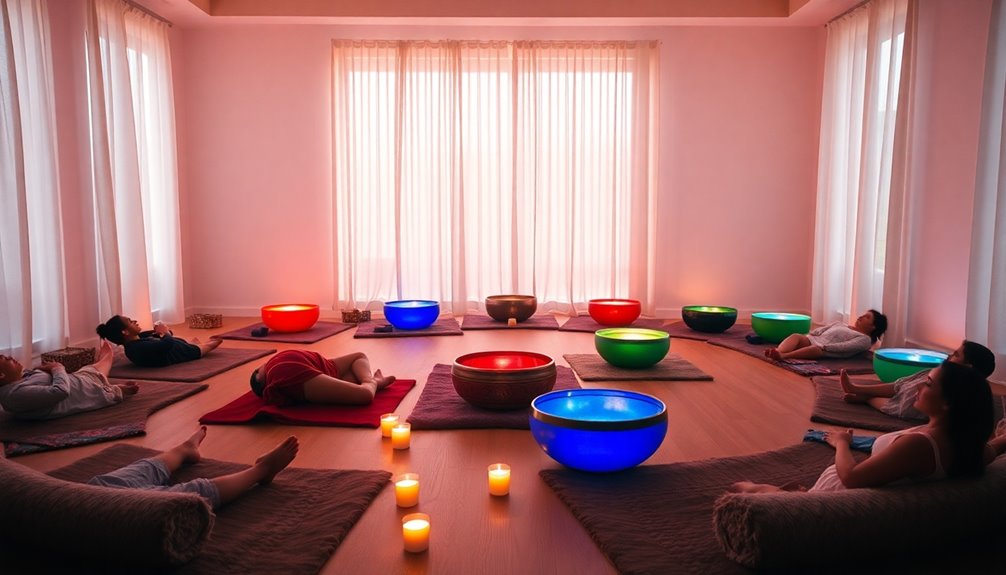Sound bath meditation uses calming sounds from instruments like singing bowls, gongs, and tuning forks to promote deep relaxation and reduce stress. Scientific studies show these vibrations can lower blood pressure, ease anxiety, and influence brainwaves to foster mental clarity and emotional balance. The frequencies work by aligning brain activity, releasing feel-good chemicals, and enhancing overall well-being. If you want to explore how sound therapy can benefit you, keep exploring the science behind the hype.
Key Takeaways
- Scientific studies show sound baths can reduce heart rate, blood pressure, and cortisol levels, indicating physiological relaxation.
- Sound vibrations influence brainwaves, promoting states of calm (theta, delta) associated with stress relief and improved sleep.
- Instruments like singing bowls and gongs emit frequencies that support emotional regulation and neuroplasticity.
- Entrainment of brainwaves through rhythmic sounds enhances mood, focus, and mental clarity.
- While evidence is promising, more research is needed to confirm long-term mental health benefits of sound bath meditation.
What Is a Sound Bath and How Does It Work?

A sound bath is a meditative experience where you immerse yourself in calming sound waves crafted by instruments like singing bowls, gongs, or tuning forks. During the session, you lie down on a yoga mat, often covered with a blanket for comfort, and listen deeply to the resonant tones. These sounds create vibrations that can influence your mental state by shifting brainwaves from alert beta states to relaxed theta or delta states, promoting relaxation and sleep. Guided breathing exercises often accompany the sounds to deepen your mindfulness. The vibrations help reduce stress and anxiety while enhancing focus inward. This full-body listening experience aims to foster mental clarity, physical relaxation, and overall well-being, making it a powerful tool for mental health and stress relief. Additionally, the environment and timing of a sound bath can be tailored to maximize its benefits, aligning with wellness practices to support mental and physical health. The vibrations from sound baths can also stimulate the body’s natural healing processes by promoting physiological balance, which can aid in reducing inflammation and supporting immune function, contributing to a sense of harmony throughout the body. Furthermore, understanding the science behind sound therapy reveals how brainwave entrainment plays a role in achieving deep states of relaxation and mental clarity, highlighting its potential benefits for mental health.
The Instruments That Create Healing Vibrations

Various instruments produce the healing vibrations central to sound bath meditation, each offering unique qualities that influence relaxation and emotional well-being. Tibetan singing bowls, made from a copper-tin alloy, produce rich harmonic overtones and sustained vibrations that promote deep relaxation. You can play them by striking or rubbing the rim to generate resonant tones. Crystal singing bowls, crafted from pure quartz, emit clear, powerful sounds that penetrate deeply into your body, often tuned to specific frequencies for chakra healing. Gongs create complex, shimmering sounds across a broad frequency range, producing vibrations that can induce trance states. Drums, like shamanic or ocean drums, offer rhythmic grounding that mirrors brainwaves and fosters emotional release. material composition of these instruments significantly influences their sound quality and healing properties. Additionally, the design and craftsmanship of these instruments can greatly affect their resonance and therapeutic effects. The size and shape of the instruments also impact the sound’s resonance and how it interacts with the environment. A variety of techniques can be employed to enhance the healing experience, depending on the instrument used. For example, the material properties of the instruments can influence the intensity and duration of vibrations, enhancing their therapeutic potential. Chimes and subtle instruments add delicate, high-frequency tones, enhancing mindfulness and relaxation.
Scientific Research on Sound Bath Benefits

Scientific studies have begun to uncover how sound bath meditation influences both body and mind. Research shows that sound baths can lower blood pressure and heart rate, indicating a calming effect on your physiology. A 2020 study with 105 participants found reduced heart rate variability, signaling decreased anxiety and stress. Earlier research also reported improvements in respiratory and cardiovascular markers, though with smaller samples. Participants often experience reduced tension and fatigue, suggesting enhanced autonomic nervous system balance. Additionally, the benefits may extend to emotional regulation, helping individuals manage their mood more effectively. Psychologically, many report mood boosts and decreased feelings of depression, anger, and anxiety. Emotional experiences during sessions can be intense, supporting deep psychological processing. Additionally, sound baths may help manage pain by relaxing muscles and calming the nervous system, contributing to overall physical and emotional well-being. The calming effects of sound bath meditation are supported by neuroplasticity, which refers to the brain’s ability to adapt and rewire itself in response to such positive stimuli. In the context of Hyundai Tuning, optimized vehicle performance can also promote a sense of well-being and stress relief during driving experiences.
How Sound Frequencies Affect Brainwaves and Mood

Sound frequencies can directly influence your brainwaves, shaping your mental and emotional states through a process called entrainment. When exposed to rhythmic sound patterns, your brain naturally syncs its waves to these external stimuli, promoting specific states. For example, alpha waves (7-12 Hz) foster calmness and creativity, while beta waves (13-30 Hz) enhance alertness and problem-solving but can increase anxiety if too high. Gamma waves (25-50 Hz) improve focus and cognitive performance. Certain frequencies also trigger neurochemical responses; alpha waves boost serotonin, promoting relaxation and pleasure. Binaural beats can guide your brain into desired states, supporting mood regulation and mental clarity. Understanding brainwave types can help you choose sound frequencies that align with your mental health goals. Additionally, the process of brainwave entrainment can be enhanced through specific sound patterns, making it easier to achieve desired mental states. Incorporating spiritual practices such as meditation and mindfulness techniques can further amplify the positive effects of sound bath meditation and promote overall well-being. Techniques like auditory stimulation can optimize your brainwave synchronization, leading to more profound relaxation. By intentionally tuning into specific sound frequencies, you can influence your emotional well-being and cognitive functioning.
Physical and Emotional Benefits of Sound Meditation

Practicing sound meditation offers powerful physical and emotional benefits that can enhance your overall well-being. It helps reduce tension, anger, fatigue, anxiety, and depression after just one hour of practice. Singing bowls can lower blood pressure and heart rate, promoting cardiovascular relaxation, while decreasing cortisol levels indicates a reduced stress response. Even beginners often experience greater stress relief than seasoned meditators. Emotionally, sound meditation decreases anxiety and depression, boosts mood, and strengthens feelings of spiritual well-being and faith. It also stimulates endorphin release, acting as a natural painkiller, which can lessen physical pain and inflammation. Additionally, regular practice improves heart health by lowering blood pressure and supports immune function. Understanding city dynamics can further enhance your experience and integration into a new environment. Incorporating sound therapy into your routine can amplify these benefits by leveraging specific frequencies and vibrations for targeted healing. Moreover, the use of mindfulness techniques can deepen your meditative state and optimize physical and emotional outcomes. The selection of appropriate sound equipment can also influence the quality and effectiveness of your meditation sessions, ensuring a more immersive experience. Recognizing the importance of AI safety measures in developing sound meditation apps can help ensure they operate reliably and securely, safeguarding users’ well-being. Overall, sound meditation nurtures both your body and mind, fostering greater resilience and calmness.
Comparing Sound Baths to Other Therapeutic Practices

While both sound baths and other therapeutic practices aim to improve well-being, they approach healing in fundamentally different ways. Sound baths use external sound waves and vibrations to induce deep relaxation, focusing on physical sensations and auditory immersion. In contrast, meditation emphasizes internal mental processes like mindfulness and breath control, with subtler physical experiences. Sound baths often provide immediate stress relief through vibrational sound, but lack extensive evidence for long-term mental health benefits, unlike traditional therapy, which involves verbal processing and structured interventions. Additionally, sound baths are usually passive group or individual experiences relying on instruments like gongs or singing bowls. Meanwhile, therapy often requires professional guidance and personalized strategies. Both methods can complement each other but serve distinct roles in wellness.
The Role of Sound Baths in Spiritual and Holistic Care

Sound baths serve a unique role in spiritual and holistic care by facilitating deeper connections with the subconscious mind and inner wisdom. You may experience enhanced meditation access through vibrational alignment with theta and delta brainwave states, allowing direct contact with your inner self. Resonant frequencies can bypass cognitive barriers, promoting introspection and revealing insights or epiphanies during sessions. Many participants report feelings of ego dissolution and unity consciousness, often linked to vibrations that balance chakras and clear energetic blockages. Additionally, sound baths activate your parasympathetic nervous system, reducing stress, lowering cortisol, and releasing somatic tension. These immersive experiences often serve as modern rituals, fostering communal healing and aligning with seasonal or spiritual practices—helping you connect deeply with your inner landscape and holistic well-being.
Technological Innovations and Future Directions

Recent technological innovations are transforming how you experience sound bath meditation, making it more accessible, personalized, and immersive than ever before. Digital sound therapy apps let you enjoy customized frequency sessions anytime, whether you’re at home or on the go, targeting relaxation, focus, or energy. Wearable devices like vibrating headphones and wristbands seamlessly incorporate therapeutic sounds into daily routines for discreet stress relief and mood boosting. Virtual Reality combines vivid visuals with layered soundscapes, creating multisensory environments that deepen your meditation practice. AI analyzes your responses and biometrics, tailoring sessions for superlative results. Advances in audio technology improve sound quality and spatial effects, heightening immersion. Together, these innovations are shaping a future where sound bath meditation becomes increasingly effective, engaging, and personalized for your mental and emotional well-being.
The Growing Popularity and Potential Clinical Uses

The popularity of sound bath meditation has surged in recent years, making it a mainstream wellness practice embraced by diverse populations. About 40% of urban adults have attended or are interested in attending sound bath sessions, and the number of studios in major cities tripled from 2019 to 2022. Mainstream media, like Condé Nast Traveller, highlights it as a top wellness trend, while celebrities like Kim Kardashian endorse it, boosting its visibility. Google data shows a 285% increase in interest between 2018 and 2019. Beyond popularity, sound baths show potential clinical benefits—70% of participants report reduced anxiety and stress, improved emotional processing, and enhanced relaxation. These factors position sound bath meditation as both a sought-after wellness activity and a promising adjunct in mental health care.
Frequently Asked Questions
Can Sound Baths Replace Traditional Medical Treatments?
You might wonder if sound baths can replace traditional medical treatments. While they help reduce stress and promote relaxation, they aren’t a substitute for professional healthcare. Sound baths are best used as a complementary therapy to support your well-being. You should continue with your prescribed treatments and consider sound baths as an additional tool for managing stress or enhancing mindfulness, not as a replacement for medical advice or intervention.
Are There Any Risks Associated With Sound Bath Meditation?
You might wonder if sound bath meditation carries risks. While generally safe, you could experience discomfort like ear pain, headaches, or dizziness, especially if you’re sensitive to loud sounds or have health issues like vertigo or metal implants. To stay safe, start with lower volumes, keep sessions short, and communicate any discomfort to your practitioner. Always consult your doctor if you have underlying health concerns before trying sound baths.
How Long Do the Benefits of a Sound Bath Last?
The benefits of a sound bath are like ripples spreading across still water, lasting for several hours after your session. You’ll likely feel relaxed, less anxious, and more mentally clear during this time. Regular visits can deepen these effects, helping you manage stress long-term. While the duration varies from person to person, most find that consistent practice keeps the calming waves flowing well beyond the initial experience.
Is Prior Meditation Experience Necessary to Benefit From Sound Baths?
You might wonder if prior meditation experience is necessary to benefit from sound baths. The evidence shows that even first-time participants experience significant tension and mood improvements, especially younger first-timers. While seasoned practitioners may have lower baseline stress, they still gain benefits. So, no, you don’t need prior experience—sound baths can help you relax and reduce stress regardless of your meditation background.
What Are the Best Environments for a Sound Bath Session?
You want to know the best environments for a sound bath session. Opt for a space with soft lighting, comfortable temperature, and ample room for participants to lie down or sit. Minimize external noise with soundproofing or quiet surroundings, and keep decor simple to focus attention on the sounds. *Guarantee* the environment promotes relaxation, using cozy mats, blankets, and calming decor to enhance the overall experience.
Conclusion
As you immerse yourself in the world of sound baths, you’ll discover they’re more than just soothing melodies—they’re gateways to inner harmony. Like a gentle tide, the vibrations wash over your mind and body, awakening dormant energies and fostering healing. Embrace this symphony of science and spirituality, knowing that each note guides you closer to balance and clarity. In this musical dance, you find not only relaxation but a deeper connection to your true self.









